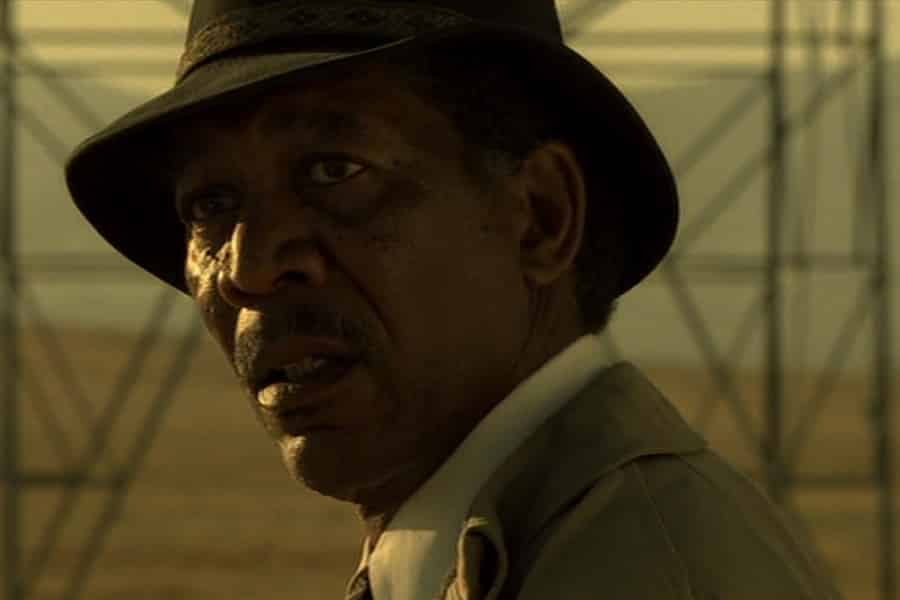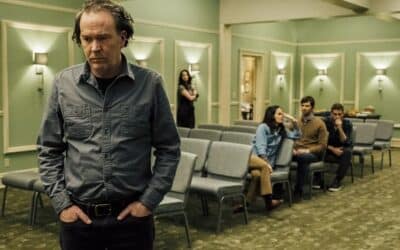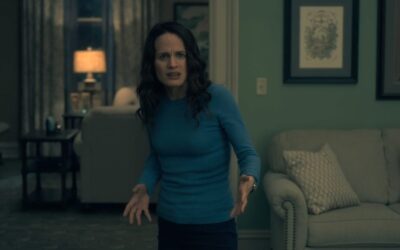
Feature
The Horror Thriller
Derik Cavignano
Horror, by its nature, is intended to scare the audience, and generally features an evil antagonist on a warpath of death and destruction. Most horror stories build toward a violent conclusion in which the central evil collides with the main characters in an inevitable showdown. In those stories, you generally know how it’ll end long before the credits roll. (i.e., Freddy or Jason will square off against the good guys in a winner-takes-all grudge match).
Thrillers, on the other hand, involve a central mystery unfolding in a way that rachets up the tension and introduces a series of twists and turns that keep the audience guessing until the unpredictable final reveal. (Think Seven or The Usual Suspects).
A horror thriller, therefore, must contain all the elements of a thriller but should also feature an antagonist worthy of a horror story. A great horror thriller is so terrifying, visceral, and shocking that it’s impossible to forget, and some of my favorites are The Shining, Seven, and The Sixth Sense.
But what is it about these stories that make them so memorable, and what key elements do they share? While experts are unlikely to agree on a single formula, I believe there are five key elements to a great horror thriller.
1. An Insidious and Terrifying Evil
First and foremost, a great horror thriller demands an insidious and terrifying evil—something so heinous and unsettling that it breeds atmosphere like a forest full of rotting flowers.
In the movie Seven, a man known as John Doe commits a series of murders against the backdrop of a dark and gritty metropolis. Each of Doe’s murders is more shocking than the next, and the visceral detail and cruelty of his crimes are intended to represent the physical embodiment of the seven deadly sins.
In the film adaptation of The Shining, Jack Torrance accepts a job as the off-season caretaker of the Overlook Hotel in the remote wilderness of Colorado, despite learning that the last caretaker succumbed to cabin fever and murdered his wife and daughters. As the staff departs and the reality of isolation sets in, Jack and his family discover they are not alone. Evil forces exist within the hotel, an evil that roams the halls and lurks behind guestroom doors, evil that’s hellbent on killing his son Danny for his psychic abilities (known as the shine).
In The Sixth Sense, a tormented young boy named Cole sees a child psychologist (Malcolm) to help cope with his terrifying visions. Cole is reluctant to tell Malcolm that he’s experiencing more than just visions, that what he actually sees is dead people walking among us, ghosts that harass and threaten him all through the day and night.
2. Flawed, But Relatable Characters
For a story to resonate with an audience, a great plot must be paired with nuanced characters who are flawed but relatable, characters whose hopes and fears remind us of ourselves or someone we know. Unlike other genres, the audience doesn’t need to like the protagonist in a horror thriller, although the character must be relatable enough to inspire feelings of empathy. Once we develop empathy for the protagonist, we become vested in the story and share in the character’s trials and tribulations, which makes the struggle against evil that much more intense.
In Seven, the protagonists include a mild-mannered veteran detective (Somerset) who is teamed up with a younger and more volatile detective (Mills) who recently moved to the city with his wife, Tracy. Somerset is six days from retirement and wants nothing more than to turn in his badge and leave the ugliness of the city behind. Mills, on the other hand, moved to the city to see more action as a homicide detective. At first, the two don’t get along, but after Tracy invites Somerset to dinner, the detectives build a camaraderie that continues to blossom as Doe’s victims pile up.
The Shining skillfully portrays Jack Torrance as both protagonist and antagonist in one of the greatest character arcs in modern fiction. When we first meet Jack, he’s a recovering alcoholic looking for a fresh start, and the job at the Overlook presents the perfect opportunity to repair his relationship with his wife Wendy, while also affording time to finally write his novel. Although we get a whiff of Jack’s temper at the outset of the story, we also get the sense that he’s working on it, that maybe breaking Danny’s arm that one time really was just a freak accident. Danny, on the other hand, is a quiet boy with an imaginary friend name Tony, who talks through Danny’s finger like a ventriloquist’s dummy. Except Tony isn’t completely imaginary—he’s Danny’s psychic alter ego, the vehicle through which Danny receives visions of what’s to come. And their future at the hotel doesn’t look promising—and not just because of what awaits them in room 237—but because his father may have a touch of the shine as well, and the forces brewing at the Overlook are beginning to drive his father stark, raving mad.
In the Sixth Sense, Cole is a likable kid with a serious problem, and the audience naturally rallies behind him and sympathizes with his situation. The story also revolves around Malcolm, who has recently returned to work after being shot by a former patient for failing to cure him of hallucinations. Since recovering from the gunshot wound, Malcolm’s relationship with his wife has deteriorated and her distant manner causes him to suspect that she may be cheating on him. Hoping to redeem his recent failures, Malcolm begins counseling Cole, whose hallucinations about seeing dead people exhibit eerie parallels to those of his former patient.
advertisement
3. An Ominous and Unfolding Mystery
The collision of flawed but relatable characters with a terrifying and insidious evil represents a great set up for any horror thriller, but it’s the introduction of an ominous and unfolding mystery that draws the audience into the pulsating heart of the story. The best mysteries are richly-layered, thought-provoking, and structured in an intricate web of plotlines that all connect in the end.
In Seven, the mystery begins to unfold when Mills and Somerset respond to a call and find a morbidly obese man who was forced to eat until his stomach ruptured. Clues found at the man’s home and at the next crime scene lead Somerset to make the connection about the seven deadly sins and the foreshadowing of five more murders.
The mystery in The Shining centers around the nature of the evil that dwells in the Overlook, how it’s influenced by Danny’s special abilities, whether Tony is Danny’s protector or something more sinister, and whether Jack will be strong enough to resist the subversive forces of the hotel. Some of the ominous details at this stage include the former caretaker’s daughters appearing to Danny in the hallway, Jack having a nightmare about hacking his family to death with an axe, Danny emerging shellshocked from room 237 with bruises on his neck, and the recurring image of blood spilling from the elevator doors.
In The Sixth Sense, the mystery unfolds when Cole confesses to Malcolm that he sees dead people and that sometimes they don’t realize they’re dead. He’s terrified by their presence and wishes more than anything to be left alone, but Malcolm suggests he try communicating with them to see what they want.
4. Palpable Suspense and Jump Scares
The first three elements represent the basic building blocks of a great horror thriller. By the midpoint of the story, we’ve got flawed but relatable characters battling a terrifying and insidious evil, and we’ve learned enough about the origins of the evil through the unfolding mystery that we’re now at the edges of our seats, about to barrel down the largest hill of the proverbial rollercoaster. The writer’s job now is to deliver a rapid-fire sequence of thrills worthy of the setup, and the best way to do that in a horror thriller is to ratchet up the suspense by putting the characters in imminent danger and creating scenes that are rife with haunting imagery, palpable suspense, and jump scares.
In Seven, the suspense cranks up when the detectives realize they’re on the trail of a deranged serial killer. After finding the victims representing gluttony and greed, they discover clues that lead them to Doe’s depiction of sloth, which appears to be an emaciated corpse strapped to a bed in a filthy apartment. As the body is prepared for transport, the victim suddenly lurches up from the bed in one of the best jump scares of all time. A break in the case occurs when the detectives discover a link to Doe from the combination of books he’s checked out of the library. When they arrive at his apartment, a thrilling chase scene ensues. Doe ultimately eludes capture, but a search of his apartment yields a clue to his next murder (lust), which is carried out by Doe holding a man at gunpoint while forcing him to rape a prostitute with a knife-tipped strap-on.
The thrills in The Shining begin in earnest when Jack investigates Danny’s claim that a woman attacked him in the bathroom of room 237. Upon entering the room, he finds a beautiful, naked woman and begins making out with her until a glance in the mirror reveals her to be a rotting corpse. Afterwards, he heads into the ballroom, which is populated by ghosts from the hotel’s past. He orders a drink from the bartender before bumping into the former caretaker, who insists that Jack take care of Danny the way he took care of his own daughters. In the meantime, while searching for Jack, Wendy finds his manuscript in the lounge, but as she flips through the pages, she sees the same sentence repeated over and over: All work and no play makes Jack a dull boy. Soon thereafter, Jack becomes completely unhinged and hunts his family through the hotel with an axe.
In The Sixth Sense, the suspense kicks up a notch after Malcolm suggests he confront the dead. Cole has several terrifying interactions with ghosts, including an angry woman who committed suicide and a teenaged boy with a gunshot wound to the head. There’s also a great jump scare when he crawls inside of his blanket fort, only to discover the ghost of a vomiting girl inside with him. After fleeing in terror, he summons the courage to approach her and asks if there’s something she wants to tell him. The next day, Cole attends a funeral reception at the girl’s house and sneaks into her room, triggering another jump scare when the girl’s arm lashes out from under the bed and grabs his leg. She pushes a box toward him, which contains a video tape that reveals the girl’s mother had been poisoning her food.
5. A Shocking Twist (Beware of Spoilers!)
Not only does a great horror thriller incorporate all of the forgoing elements, but it also has a shocking twist, something terrifying and unexpected, something that makes it truly unforgettable.
Seven concludes with a series of twists that build upon each other for one of the darkest finales of any horror thriller. The first twist occurs when Doe turns himself in, covered in blood, and confesses to murder. He promises to take detectives Somerset and Mills to the final two murder victims in exchange for not pleading insanity when the case goes to trial. As they arrive at a remote desert location, a delivery van approaches, and the driver presents them with a box. As Somerset opens the box and peers inside, Doe tells Detective Mills that he was envious of the detective’s relationship with his wife. Doe says he visited the detective’s home and tried to play husband. “It didn’t work out,” he says. “So I took a souvenir—her pretty head.” Mills doesn’t want to believe that Tracy was Doe’s representation of envy, but when Somerset doesn’t deny it, Mills fatally shoots Doe, thus committing wrath—the last of the seven deadly sins—and finishing Doe’s work for him.
The Shining concludes with Danny hiding from his axe-wielding father in a snowy topiary maze. After eluding Jack in the maze and leaving him to freeze to death, Danny reunites with his mother outside of the hotel. The scene cuts away to an interior shot of the Overlook, the camera slowly panning to a wall of photos, zooming in on a snapshot of a crowded ballroom. The photo is dated July 4, 1921 and features Jack smiling in a tuxedo, implying that he’s always been the caretaker of the hotel.
In The Sixth Sense, Cole’s actions at the girl’s funeral reception facilitate her passage to the other side, which teaches him that he can coexist with the ghosts. Thankful for Malcolm’s guidance and wanting to return the favor, Cole suggests that Malcolm should repair his relationship with his wife by talking to her while she sleeps. Malcolm takes Cole’s advice and she responds in her sleep by asking why he left her. The question confuses Malcolm until he watches his wedding ring slip from her fingers, and he realizes that he never survived the gunshot wound and is a ghost, himself.
So there you have it—the five essential elements of a great horror thriller. The next time you read or watch one, see how many of the elements you can spot.
About the Author
Derik Cavignano writes character-driven stories in a variety of genres, including horror and suspense thrillers. In his latest horror thriller, THE ART OF DYING, the bizarre death of a mob foot soldier sparks an escalating war between Boston’s Irish and Italian mafia, but one detective’s relentless search for the truth uncovers evidence of a serial killer obsessed with the art of human suffering. Awards for Derik’s novels include the National Indie Excellence Awards, Best Book Awards, American Fiction Awards, and the Silver Falchion Award. You can find him at derikcavignano.com, on Twitter, or visit his Amazon author page: Amazon.com: Derik Cavignano.

More Horror Features
Horror Through the Ages
A Journey Through Time and Terror
Technology in Horror
When gadgets become nightmares
Female Characters in Horror
From Victims to Heroes
Advertisement



